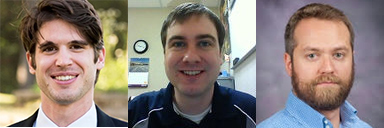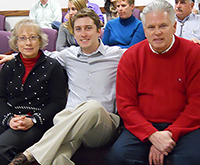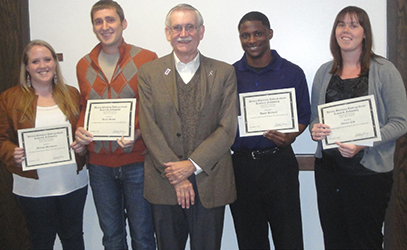
Visual Cognition Laboratory
Welcome to the Home of Dr. Les Loschky's KSU Visual Cognition Laboratory!
Dr. Loschky is currently accepting applications for graduate students for 2024.
Three major themes in the lab across both basic and applied research domains are:
- Attention & Learning from multimodal educational materials (see 3 National Science Foundation [NSF] grants on this topic.)
- Scene perception and event comprehension (see new book chapter on the Scene Perception & Event Comprehension Theory (SPECT))
- Scene perception from central to peripheral vision (see special issue Les Loschky has Guest-Edited for the Journal of Vision on this topic)
The Visual Cognition Lab conducts research on scene perception and its real world applications, spanning the traditional areas of perception and cognition. Our lab's research philosophy is that good basic research should always be capable of suggesting applications for real-world scenarios, and good applied research should always add information to a theory.
Our basic research studies how people perceive, attend to, understand, and remember scenes and the objects in them. Our research investigates the time course for perceiving and creating a mental representation of a scene. First, how can we view a scene and grasp its category very quickly (within the first tenth of a second), easily distinguishing between an office versus a hallway or a parking lot versus a park? Do our expectations of what scene we will see next influence our ability to rapidly recognize that scene? Next, as we observe such a scene, what causes us to look at certain objects and ignore others, and how does that affect our memory? When the scenes we are looking at form a narrative, such as in a picture story or movie, how does our understanding affect what we pay attention to, and how does what we pay attention to affect our understanding? We have researched all of these questions, and have developed the Scene Perception & Event Comprehension Theory (SPECT) as a framework for understand how people's eye movements and attention influence their understanding of what they see, and how our understanding influences what we look at and remember.
Our applied work focuses on key questions in education and human factors related to attention, ranging from learning from online Physics education to driving and transportation safety.
In the area of Education, our research is aimed at overcoming a key problem in online learning, namely, how can teachers know if their students are engaged and paying attention? Furthermore, how does this affect online learning? To answer these questions, we are using eye movements to measure students' attention spans, and relating their attention to tests of their learning. This includes using machine learning to predict when learners' attention spans have been exceeded. We will use this research to build smarter computerized on-line instruction that incorporates eye tracking and machine learning. This will help online instructors improve their lessons by tracking their students' attention spans. It will help learners by suggesting that they take a break when their attention spans have been exceeded. Additionally, we can cue learners' attention to the most important information for learning. We are also studying how a person's eye movements can be used to determine whether their learning materials are causing them difficulty in learning (i.e., cognitive load), or if the materials are promoting learning through the right level of challenge.
In the domain of driving safety, we have studied how cognitive load, such as performing two difficult tasks at the same time, affects the perception while driving. Specifically, how does adding a cognitive load affect either central or peripheral vision– that is, does focusing on a different task make people less likely to notice something right in front of them, or in their peripheral vision? For this, using eye tracking, we have developed a new measure of how much information in a driver's visual field they can pay attention to at any given moment while driving, namely their Useful Field of View (UFOV). We have shown how a driver's breadth of attention dynamically changes while driving depending on their level of cognitive load (e.g., driving while listening and thinking hard about something). We have also shown how a person's UFOV also changes based on what they see and understanding going on around them. For example, people's UFOV seems to spread wider when they are not sure what is going to happen next, and gets narrower once they understand what is going on. This work can be applied to improving transportation safety by creating better dynamic tests of a person's UFOV in driving situations, and can be used to train people to improve their UFOV.
Current and previous funding sources for our lab include the Office of Naval Research (ONR) and the National Science Foundation (NSF).
Lab News
|
Dr. Loschky and colleagues were awarded a $1.5 million grant from the National Science Foundation (NSF) to study the effects of attention on learning from online instruction. 3 Vis Cog Lab PhD Students Successfully Defended their Dissertations in the Summer of 2018! Congratulations to all 3!!! And many thanks to all the undergrad RAs who helped them!!! Happily, all 3 are now gainfully employed!! L-R: John Huston, Jared Peterson, Ryan Ringer
|
|
Dr. Loschky and collaborators have been awarded a $1.2 million grant from the National Science Foundation (NSF) to conduct research on using visual cues to facilitate problem solving for math and physics problems. |
|
Adam Larson (center) graduated with his Ph.D. in May 2012. He worked as a Post-Doctoral Research Associate in the Visual Cognition Lab from 2012 – 2013, and is now an Assistant Professor of Psychology at the University of Findlay. |
|
Undergraduate research assistant Allison Coy (far right) was a recipient of the Doreen Shanteau Undergraduate Research Award in October 2012. She has been conducting her research over the last year on the phenomenon of visual crowding in peripheral vision. |
|
Tyler Freeman graduated with his Ph.D. in May 2012. He worked at the Army Research Institute in Fort Leavenworth, Kansas, and is now a Research Associate at ICF International. |


